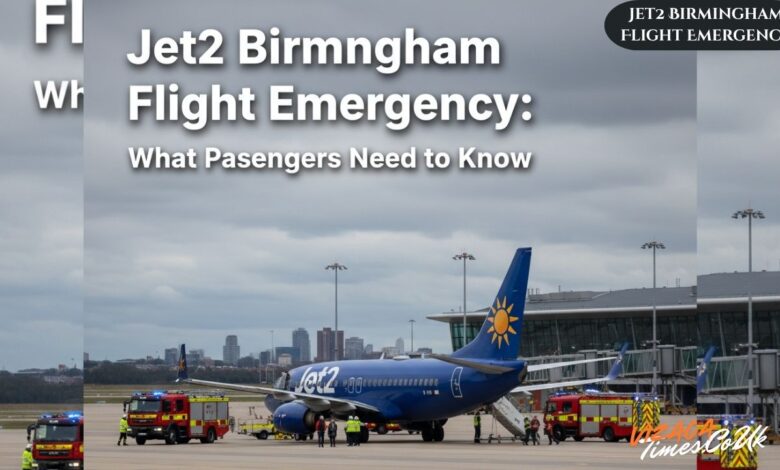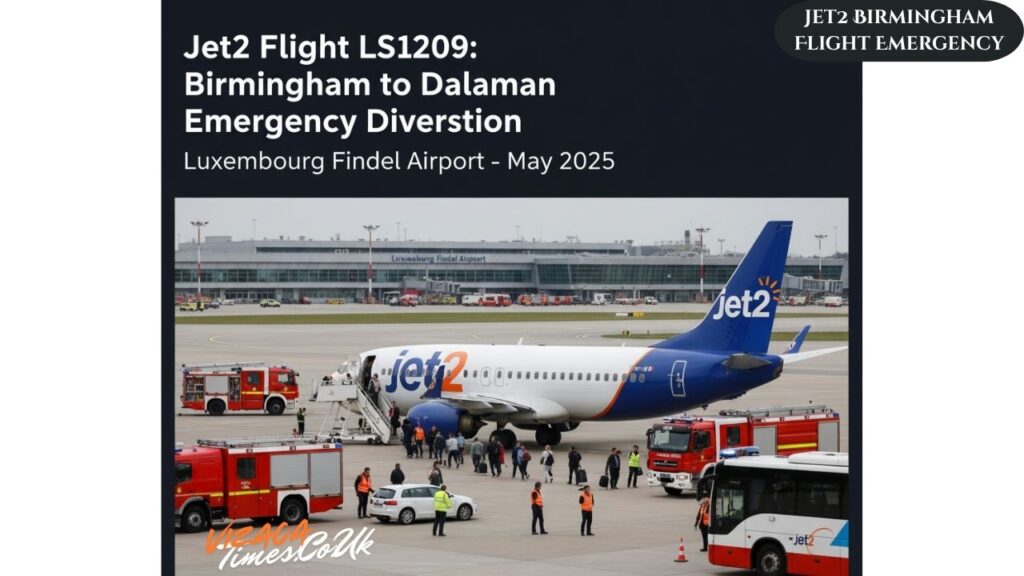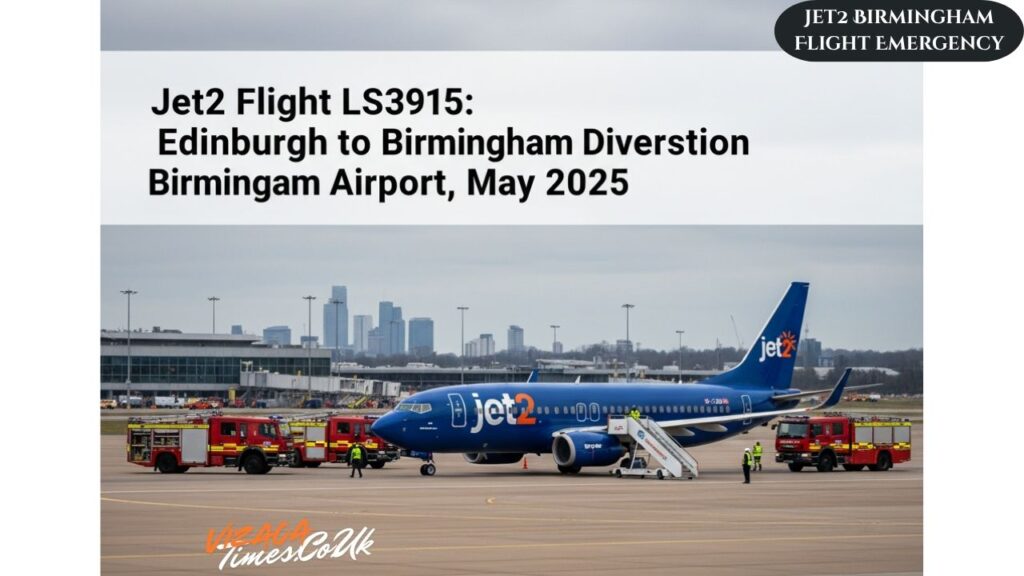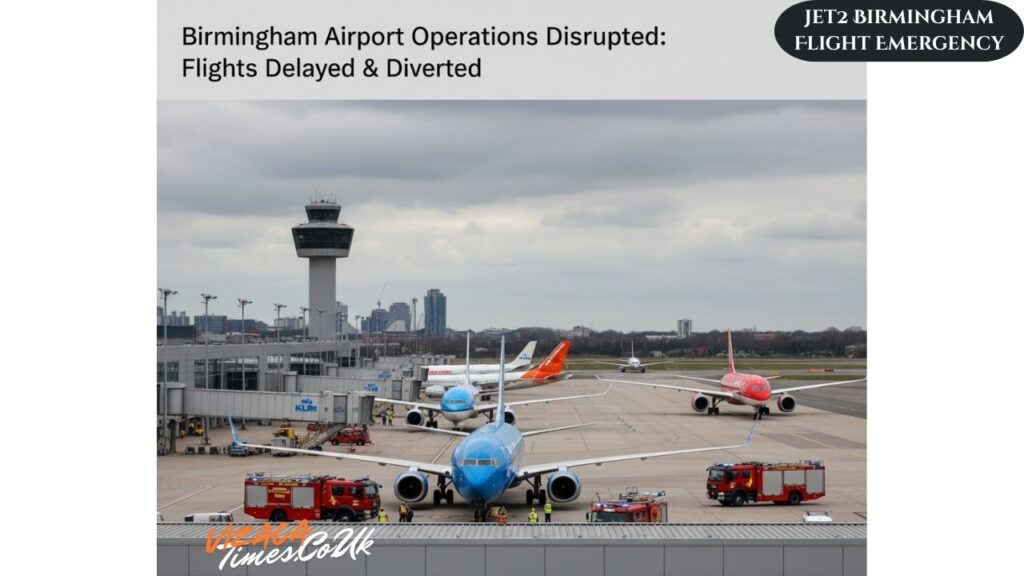Jet2 Birmingham Flight Emergency What Passengers Need to Know

Introduction
Birmingham Airport serves as a major hub for Jet2 Airlines, handling thousands of passengers traveling to popular European destinations throughout the year. The airline has built a reputation for reliable service and competitive pricing, making it a preferred choice for many travelers departing from the Midlands region.
Recent emergency incidents involving Jet2 flights have drawn attention to the airline’s safety protocols and emergency response procedures. While such events are rare in modern aviation, they highlight the critical importance of crew training, aircraft maintenance, and coordinated emergency responses between airlines and airport authorities.
Aviation safety remains the top priority for all airlines operating from Birmingham Airport. Understanding how emergencies are managed and what passengers can expect during such situations provides valuable peace of mind for travelers choosing Jet2 for their journeys.
Birmingham to Dalaman Emergency (May 2025)

Flight Details
In early May 2025, Jet2 flight LS1209 was operating a scheduled service from Birmingham to Dalaman, Turkey. The aircraft carried 183 passengers who were looking forward to their holiday destination. The flight departed Birmingham Airport as planned, with crews following standard operational procedures for the journey to the Turkish resort city.
Emergency Situation
While cruising at 37,000 feet over France, the flight crew detected smoke within the aircraft. This triggered immediate emergency protocols, and the pilots declared a mid-air emergency by issuing the international distress code, squawk 7700. This code alerts air traffic control that the aircraft requires priority handling and assistance.
The detection of smoke during flight is considered a serious situation requiring immediate action. The crew’s quick response and adherence to emergency procedures ensured that appropriate measures were taken to protect everyone on board.
Diversion and Landing
Following the emergency declaration, the pilots made the decision to divert to the nearest suitable airport. Luxembourg Findel Airport was selected as the emergency landing destination, and the aircraft was guided safely to the ground. Emergency services were positioned and ready as the plane touched down.
All passengers disembarked safely, and the airline worked to ensure their welfare following the unexpected landing. The incident demonstrated the effectiveness of aviation safety protocols and the importance of crew training in handling unexpected situations.
Edinburgh to Birmingham Diversion (May 2025)

Flight Information
Another notable incident occurred in May 2025 involving Jet2 flight LS3915. This service was operating from Edinburgh to Birmingham Airport aboard a Boeing 737-800 aircraft with registration G-JZDA. The flight departed from Edinburgh at approximately 6:50 AM, with passengers expecting a routine journey to the Midlands.
Emergency Declaration
Approximately 30-40 minutes after departure, the flight crew identified a situation requiring emergency protocols. The pilots issued squawk 7700, signaling air traffic control that the aircraft needed priority handling. The decision was made to continue toward Birmingham rather than return to Edinburgh.
Emergency squawk codes serve as critical communication tools between pilots and air traffic controllers, ensuring that aircraft experiencing difficulties receive immediate attention and priority clearance.
Landing at Birmingham
The Jet2 flight successfully landed on runway 33 at Birmingham Airport. In this instance, Birmingham Airport served as the emergency diversion point rather than the departure airport. Emergency services were prepared, and the aircraft landed without further incident.
Passengers were able to disembark normally, and the airline provided necessary support and information following the landing. The successful resolution highlighted the coordination between flight crews and airport emergency response teams.
Impact on Birmingham Airport Operations

Disruptions to Other Flights
Emergency landings and diversions can create ripple effects throughout airport operations. Following the Jet2 incidents, several other airlines experienced disruptions, including KLM, EasyJet, and Air India services. These carriers faced delays as Birmingham Airport managed the emergency situations and ensured safety remained the primary focus.
Temporary Runway Closures
When emergency aircraft land, airports may temporarily close runways to ensure adequate emergency service positioning and aircraft inspection. These brief closures are necessary safety measures but can impact scheduled departures and arrivals.
Airport Emergency Response Procedures
Birmingham Airport maintains comprehensive emergency response procedures involving fire services, medical teams, and airport operations staff. These coordinated efforts ensure that any aircraft declaring an emergency receives appropriate support upon landing.
Delays and Diversions Resulting from Incidents
The cascading effects of emergency situations can lead to delays for other flights and, in some cases, diversions to alternative airports. Passengers affected by these secondary impacts are entitled to information and support from their respective airlines.
Aviation Safety Protocols
Emergency Squawk Codes Explained
Squawk 7700 is the international emergency code used in aviation. When pilots enter this code into their transponder, it immediately alerts air traffic controllers that the aircraft requires priority handling. This system ensures rapid response regardless of where the aircraft is flying.
Pilot Decision-Making During Emergencies
Flight crews undergo extensive training to handle emergency situations. Their decision-making process considers factors such as the nature of the emergency, weather conditions, nearest suitable airports, and passenger safety. Pilots have authority to make necessary decisions to ensure safe outcomes.
Diversion Procedures and Nearest Suitable Airports
When an emergency requires landing before reaching the intended destination, pilots evaluate nearby airports based on runway length, emergency services availability, and weather conditions. The goal is always to land safely at the most appropriate facility.
Communication with Air Traffic Control
Continuous communication between pilots and air traffic control ensures that emergency aircraft receive priority routing, runway clearance, and coordination with ground-based emergency services. This partnership is fundamental to aviation safety.
Jet2’s Response and Safety Record
Airline’s Handling of Emergency Situations
Jet2 Airlines maintains protocols for managing emergency situations, ensuring that crews have clear guidelines and support throughout any incident. The airline’s response includes coordinating with airport authorities and providing passenger assistance.
Passenger Communication and Support
Following emergency situations, Jet2 provides passengers with information about the incident, next steps, and available support services. The airline works to minimize disruption and ensure passengers can continue their journeys or make alternative arrangements.
Investigation Procedures
Following any significant incident, airlines conduct thorough investigations to determine causes and identify opportunities for improvement. These reviews help enhance safety protocols and prevent similar situations in the future.
Safety Measures and Protocols
Jet2 Airlines adheres to strict safety standards required by aviation authorities. Regular aircraft maintenance, crew training programs, and operational oversight all contribute to maintaining high safety standards across the fleet.
Passenger Experience and Rights
What Happens During an Emergency Landing
During an emergency landing, passengers will receive instructions from the cabin crew. These may include reviewing safety procedures, assuming brace positions if necessary, and remaining calm while following crew directions. The experience can be unsettling, but crews are trained to manage situations professionally.
Passenger Rights for Diverted Flights
When flights are diverted to alternate airports, passengers have rights to information, assistance, and in many cases, continuation of their journey. Airlines must provide care appropriate to the delay duration, including meals and accommodation if necessary.
Compensation and Rebooking Policies
Depending on the circumstances and applicable regulations, passengers may be entitled to compensation for significant delays or cancellations. Airlines typically offer rebooking on the next available flight or refunds for unused portions of travel.
Emotional Impact and Support Services
Emergency situations can be stressful for passengers. Airlines recognize this and often provide support services or referrals to help travelers process their experiences. Understanding that trained professionals managed the situation safely can provide reassurance.
Conclusion
Overall Safety of Air Travel
Despite occasional emergency situations, air travel remains one of the safest forms of transportation. The aviation industry’s commitment to safety, combined with advanced technology and rigorous training standards, ensures that flights operate with minimal risk.
Importance of Crew Training and Emergency Preparedness
The successful resolution of emergency situations demonstrates the value of comprehensive crew training programs. Pilots and cabin crew members undergo regular emergency procedure training, enabling them to respond effectively when unexpected situations arise.
Lessons Learned from These Incidents
Each incident provides valuable learning opportunities for airlines and aviation authorities. Reviewing emergency responses helps identify areas for improvement and reinforces the importance of maintaining strict safety protocols.
Future Implications for Birmingham Airport Operations
Birmingham Airport continues to enhance its emergency response capabilities and coordination with airlines operating from the facility. These ongoing improvements benefit all passengers traveling through the airport, regardless of their chosen carrier.
For passengers planning to use Jet2 services from Birmingham, these incidents serve as reminders that aviation safety systems work effectively. The airline’s crews, combined with airport emergency services, demonstrated their ability to handle unexpected situations professionally and safely.
Helpful Resources for Passengers
Checking Your Jet2 Flight Status
Passengers can monitor their Jet2 flight status through multiple channels. The airline provides real-time updates on departures and any schedule changes that might affect travel plans.
Using Jet2 Flight Tracker Tools
A Jet2 flight tracker allows passengers and those meeting travelers to monitor aircraft locations in real-time. These tools show departure times, estimated arrival times, and current flight positions.
Monitoring Jet2 Departures
Checking Jet2 departures before heading to Birmingham Airport helps passengers stay informed about any delays or gate changes. The airline updates its departure information regularly throughout the day.
Understanding Flight Tracking Systems
Modern flight tracking technology, including the Jet 2 flight tracker, provides transparency and peace of mind for travelers. These systems use aircraft transponder data to show flight paths, altitudes, and speeds in real-time, allowing anyone to follow a flight’s progress from departure to arrival.
Also Read: Lake Texoma Should Be Capitalized – Grammar, Geography, and Style



